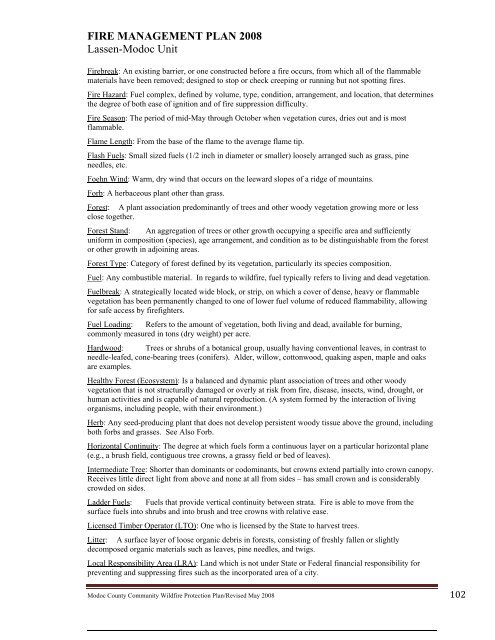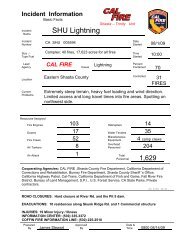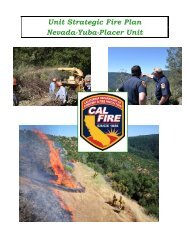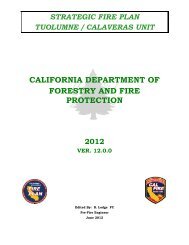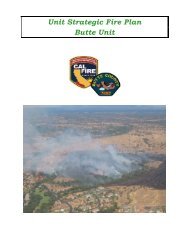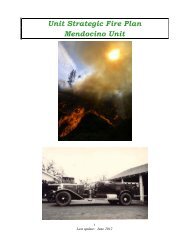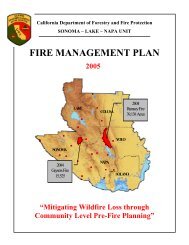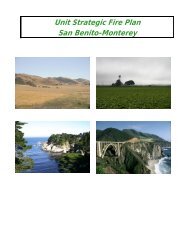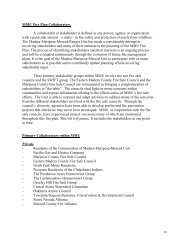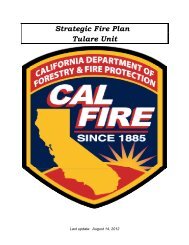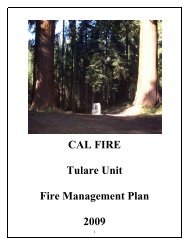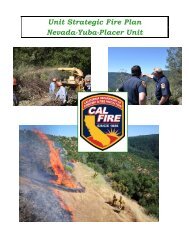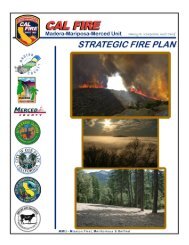Lassen – Modoc Unit - Board of Forestry and Fire Protection - State ...
Lassen – Modoc Unit - Board of Forestry and Fire Protection - State ...
Lassen – Modoc Unit - Board of Forestry and Fire Protection - State ...
You also want an ePaper? Increase the reach of your titles
YUMPU automatically turns print PDFs into web optimized ePapers that Google loves.
FIRE MANAGEMENT PLAN 2008<br />
<strong>Lassen</strong>-<strong>Modoc</strong> <strong>Unit</strong><br />
<strong>Fire</strong>break: An existing barrier, or one constructed before a fire occurs, from which all <strong>of</strong> the flammable<br />
materials have been removed; designed to stop or check creeping or running but not spotting fires.<br />
<strong>Fire</strong> Hazard: Fuel complex, defined by volume, type, condition, arrangement, <strong>and</strong> location, that determines<br />
the degree <strong>of</strong> both ease <strong>of</strong> ignition <strong>and</strong> <strong>of</strong> fire suppression difficulty.<br />
<strong>Fire</strong> Season: The period <strong>of</strong> mid-May through October when vegetation cures, dries out <strong>and</strong> is most<br />
flammable.<br />
Flame Length: From the base <strong>of</strong> the flame to the average flame tip.<br />
Flash Fuels: Small sized fuels (1/2 inch in diameter or smaller) loosely arranged such as grass, pine<br />
needles, etc.<br />
Foehn Wind: Warm, dry wind that occurs on the leeward slopes <strong>of</strong> a ridge <strong>of</strong> mountains.<br />
Forb: A herbaceous plant other than grass.<br />
Forest: A plant association predominantly <strong>of</strong> trees <strong>and</strong> other woody vegetation growing more or less<br />
close together.<br />
Forest St<strong>and</strong>: An aggregation <strong>of</strong> trees or other growth occupying a specific area <strong>and</strong> sufficiently<br />
uniform in composition (species), age arrangement, <strong>and</strong> condition as to be distinguishable from the forest<br />
or other growth in adjoining areas.<br />
Forest Type: Category <strong>of</strong> forest defined by its vegetation, particularly its species composition.<br />
Fuel: Any combustible material. In regards to wildfire, fuel typically refers to living <strong>and</strong> dead vegetation.<br />
Fuelbreak: A strategically located wide block, or strip, on which a cover <strong>of</strong> dense, heavy or flammable<br />
vegetation has been permanently changed to one <strong>of</strong> lower fuel volume <strong>of</strong> reduced flammability, allowing<br />
for safe access by firefighters.<br />
Fuel Loading: Refers to the amount <strong>of</strong> vegetation, both living <strong>and</strong> dead, available for burning,<br />
commonly measured in tons (dry weight) per acre.<br />
Hardwood: Trees or shrubs <strong>of</strong> a botanical group, usually having conventional leaves, in contrast to<br />
needle-leafed, cone-bearing trees (conifers). Alder, willow, cottonwood, quaking aspen, maple <strong>and</strong> oaks<br />
are examples.<br />
Healthy Forest (Ecosystem): Is a balanced <strong>and</strong> dynamic plant association <strong>of</strong> trees <strong>and</strong> other woody<br />
vegetation that is not structurally damaged or overly at risk from fire, disease, insects, wind, drought, or<br />
human activities <strong>and</strong> is capable <strong>of</strong> natural reproduction. (A system formed by the interaction <strong>of</strong> living<br />
organisms, including people, with their environment.)<br />
Herb: Any seed-producing plant that does not develop persistent woody tissue above the ground, including<br />
both forbs <strong>and</strong> grasses. See Also Forb.<br />
Horizontal Continuity: The degree at which fuels form a continuous layer on a particular horizontal plane<br />
(e.g., a brush field, contiguous tree crowns, a grassy field or bed <strong>of</strong> leaves).<br />
Intermediate Tree: Shorter than dominants or codominants, but crowns extend partially into crown canopy.<br />
Receives little direct light from above <strong>and</strong> none at all from sides <strong>–</strong> has small crown <strong>and</strong> is considerably<br />
crowded on sides.<br />
Ladder Fuels: Fuels that provide vertical continuity between strata. <strong>Fire</strong> is able to move from the<br />
surface fuels into shrubs <strong>and</strong> into brush <strong>and</strong> tree crowns with relative ease.<br />
Licensed Timber Operator (LTO): One who is licensed by the <strong>State</strong> to harvest trees.<br />
Litter: A surface layer <strong>of</strong> loose organic debris in forests, consisting <strong>of</strong> freshly fallen or slightly<br />
decomposed organic materials such as leaves, pine needles, <strong>and</strong> twigs.<br />
Local Responsibility Area (LRA): L<strong>and</strong> which is not under <strong>State</strong> or Federal financial responsibility for<br />
preventing <strong>and</strong> suppressing fires such as the incorporated area <strong>of</strong> a city.<br />
<strong>Modoc</strong> County Community Wildfire <strong>Protection</strong> Plan/Revised May 2008 102


